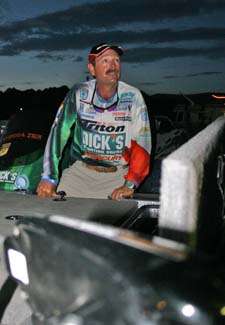
MONETA, Va. — The phrase is "gin-clear," when the water is so clean that an angler can discern a fish's eye color, and the fish can read the sponsor logo on the angler's cap.
Smith Mountain Lake, where the Blue Ridge Brawl presented by Advance Auto Parts is entering its third day Saturday, is not the clearest lake on the Bassmaster Elite Series tour.
Anglers interviewed at the launch point before dawn said that distinction would more likely go to Texas' Lake Amistad, or perhaps Nevada's Lake Mead. But under mostly cloudless skies, and with only the gentlest of breezes, the lake this week has been so glassy that, in places, anglers can see the bottom 8 or 10 feet beneath them.
"The slick H2O, hot, blue skies, is what I want," said Shaw Grigsby, who sits in fifth place after two days. "This is the way I love to fish. It's just fun."
But the lake's lucidity, according to angler Greg Hackney, "is a double-edged sword. You know they're there, but it's frustrating when you can't catch them. And sometimes it makes you do things you wouldn't usually do."
Some anglers shy away from the clear water for the obvious reasons: with such a clear view, fish are easily spooked by an angler's presence, and they're able to see baits well enough that presentation becomes even trickier.
"I don't feel too comfortable fishing this gin-clear water," said Fred Roumbanis (9th place, 26 pounds, 15 ounces). "It's already bad enough here when all the girls are going by on jet skis and boats, trying to get your attention."
Were some wind blowing, he'd feel more comfortable — "it breaks up the surface, and they're not getting a perfect image of you" — but this week he has stuck to fingers of the lake that have some color to the water.
Marty Stone, on the other hand, has made his living (and his first top-50 cut of this season) fishing in 2 to 5 feet of crystalline water. "It's strictly a sight bite," he said.
The benefit, though, is that "you can draw fish from a long ways off." The drawback is that fish will close in on a bait and turn away at the last moment. "It really is hard to fool Mother Nature," he said.
To do so, he said, he'll cast his baits some distance away from the fish, and off to one side. Just as an angler can see the fish and vice-versa, the fish's prey would also be able to see well enough to avoid the fish. Stone reasons that a bass knows enough to mistrust a bait that comes too close to it, because a bait fish would make no such mistake in those conditions.
Of course, when they're not biting, an angler's failure is on full display for him to behold — a phenomenon that has struck many of the pros this week. "You get aggressive with it," Stone said. "You get frustrated, and you want to put it down and do something else."
Jason Quinn avoids that conundrum by fishing a hole quickly, working his baits as fast as he can, and moving to the next spot. "I throw it; if he bites, I catch him. If not, I move on," Quinn said.
The clarity of the lake allowed Quinn (30th, 23-14) to dive right in, so to speak, without scouting the lake ahead of time. When a friend asked him before the tournament whether he would fish the lake before the off-limits went into effect, he replied, "Why? It's in June." Later in the summer, the fish will be too deep to see. Post-spawn, though, the fish are high enough that he can find them without having to hunt for underwater structure.
In contrast to Quinn, the key for James Kennedy in clear water has been fishing slowly and with light line. The Louisianan is more comfortable flipping 15- to 30-pound test, but has been reduced to using line as small as 4-pound test.
"You adapt," he said. "You make them bite it." Friday, in dead-calm water, he caught a 4-pound smallmouth — the first smallie he'd ever caught.
